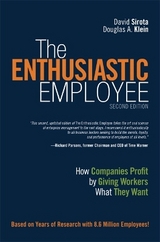
The Enthusiastic Employee
Pearson FT Press (Verlag)
978-0-13-324902-6 (ISBN)
- Titel erscheint in neuer Auflage
- Artikel merken
David Sirota has two abiding professional interests: organization behavior and survey research. Both of these interests took hold at the University of Michigan, where he received his doctorate, and where he worked at that university’s Institute for Social Research, a leading center for applying survey methods to the study of organizations. Upon receiving his doctorate, David was recruited by International Business Machines (IBM) to help initiate behavioral science research there. He stayed at IBM for 12 years in a variety of research and executive positions, leaving in 1972 to set up his own firm, Sirota Consulting, now simply Sirota. The firm specializes in the diagnosis and improvement of the relationships of organizations with all of their key constituencies: employees, customers, suppliers, investors, and communities. In 1996, David became chairman emeritus of the firm, after completing his own succession plan with key employees. He continues to consult with selected clients, primarily on matters of leadership, and collaboration and conflict within and between organizations. Parallel to his career as a consultant, David has had an academic career, having taught at the School of Industrial and Labor Relations of Cornell University, the School of Industrial Administration of Yale University, the Sloan School of the Massachusetts Institute of Technology, and the Wharton School of the University of Pennsylvania. David is married with two children and lives in New York City. Douglas Klein is, likewise, steeped in survey research, with 25 years of experience in the field. Prior to joining Sirota, he worked for AT&T, building leadership assessment centers and conducting employee research, and then at Time Warner, where he conducted employee and customer satisfaction research. Doug brought his insights into employee and customer research to Sirota and helped launch its “linkage” efforts, statistically relating employee attitudes, customer attitudes, and “hard” business metrics. He managed the normative database for the firm for more than a decade (on which so much in the book’s first and second editions is based) and is seen by many as a real historian of employee attitudes. His current role as the firm’s chief leadership advisor allows him to apply his strong analytical skills and decades of client experience to issues of organizational values and culture and to the day-to-day problems faced by senior executives in the management of their companies. Doug is an active advisor, speaker, and writer. (See his blog on www.sirota.com and search for the many articles he has authored or to which he has contributed.) He holds a master’s degree in industrial and organizational psychology from New York University. Doug lives in Merrick, New York, with his wife Ilene and their two children.
Acknowledgments xi
About the Authors xiii
About the Second Edition xv
Our New Website xx
Introduction 1
Asking the Questions 4
Asking the Right Questions 4
Questions Result in Data 6
After the Honeymoon 11
A Quick Look at “Old-Fashioned” Theories 12
Solid Theory, Research, and Management Practice to Which We Are in Debt 15
How This Book Is Organized 15
Part I Worker Motivation, Morale, and Performance 17
Chapter 1 What Workers Want—The Big Picture 19
Blame It on the Young 20
The Lordstown Strike and Job Enrichment “Solution” 22
The Generation Gap Mythology Re-Emerges 24
Myths About the Work Itself 29
The Sirota Three-Factor Theory 32
The Specific Evidence for the Three-Factor Theory 45
How the Three Factors Work in Combination 52
Racial/Ethnic and Gender Differences 55
Individual Differences 62
Chapter 2 Employee Enthusiasm and Business Success 67
Making the Connection 67
Telling Us in Their Own Words 69
A Few Leading Organizations 74
“Enthusiasm” Versus “Engagement” 79
Enthusiasm and Performance: The Research Evidence 81
Building the People Performance Model 86
Part II Enthusiastic Workforces, Motivated by Fair Treatment 93
Chapter 3 Job Security 95
Specific Job Security Policies and Practices 107
Chapter 4 Compensation 117
Money as Seen by Workers 117
Money as Seen by Employers 118
Levels of Pay 122
Paying for Performance 133
Recommendations 143
A Note on Merit Pay for Teachers 157
Chapter 5 The Impact of the Great Recession: Flight to Preservation 161
The Survey Results 165
The Role of Management 176
Chapter 6 Respect 181
The Heart of Respect 184
Humiliating Treatment 186
Indifferent Treatment 188
The Specifics of Respectful Treatment 193
Physical Conditions of Work 195
Status Distinctions 196
Compensation Status Is a Fundamental Distinction 200
Job Autonomy 203
Constrained Communication 206
Part III Enthusiastic Workforces, Motivated by Achievement 213
Chapter 7 Organization Purpose and Principles 215
Elements of Pride in One’s Company 215
The Impact on Performance of “Doing Good” 219
Short- Versus Long-Term Profit Horizon 225
More About Purpose 231
More About Principles 232
Ethics in the Treatment of Employees 233
Getting Practical: Translating Statements of Purposes and Principles into Practice 238
Chapter 8 Job Enablement 255
Ah, Bureaucracy! The Evil That Just Won’t Go Away 262
A Management Style That Works 269
Layers of Management 274
The Benefits of Self-Managed Teams 278
Telecommuting: Yahoo Bans Work-From-Home 283
Chapter 9 Job Challenge 295
Is This an Aberration, Are Workers Delusional, or Are They Lying? 297
Given a Choice, Few People Volunteer to Fail 300
Push and Pull 302
Chapter 10 Feedback, Recognition, and Reward 313
Do Workers Get the Feedback They Need? 313
Guidance 315
A Short Course on Giving Cognitive Feedback 318
Evaluation, Recognition, and Reward 330
What Makes for Effective Recognition of Workers? 333
Advancement 340
The Other Side of the Equation: Dealing with Unsatisfactory Performance 343
Feedback Sets Priorities 347
Part IV Enthusiastic Workforces, Motivated by Camaraderie 349
Chapter 11 Teamwork 351
A Look Back 352
Are We Doing Better Now? 353
Socializing While Working 354
Uncooperative Co-Workers Have an Exponentially Negative Effect 356
Contentious Workgroups Are Drags on the Organization 357
Building Partnership 362
How Can the Misperceptions Be Uncovered, Confronted, and Corrected? 364
Lay the Foundation Prior to the Workshop 367
Establish Workshop Ground Rules 367
A Typical Workshop Agenda 369
Action Example: IT and Its Users 370
Part V Bringing It All Together: The Culture of Partnership 375
Chapter 12 The Culture of Partnership 377
Application to Other Constituencies 395
A Cultural Case Study of Mayo Clinic 396
Partnership in These Times 405
Chapter 13 Leadership and the Partnership Culture 411
The Critical Importance of Effective Leadership 412
Trust 414
Charisma 417
The Nine Key Leadership Attributes 421
Chapter 14 Translating Partnership Theory into Partnership Practice 431
It Starts at the Top 433
The Action Process 436
Endnotes 457
Index 479
| Erscheint lt. Verlag | 5.9.2013 |
|---|---|
| Verlagsort | NJ |
| Sprache | englisch |
| Maße | 163 x 236 mm |
| Gewicht | 830 g |
| Themenwelt | Wirtschaft ► Betriebswirtschaft / Management ► Personalwesen |
| ISBN-10 | 0-13-324902-6 / 0133249026 |
| ISBN-13 | 978-0-13-324902-6 / 9780133249026 |
| Zustand | Neuware |
| Haben Sie eine Frage zum Produkt? |
aus dem Bereich



